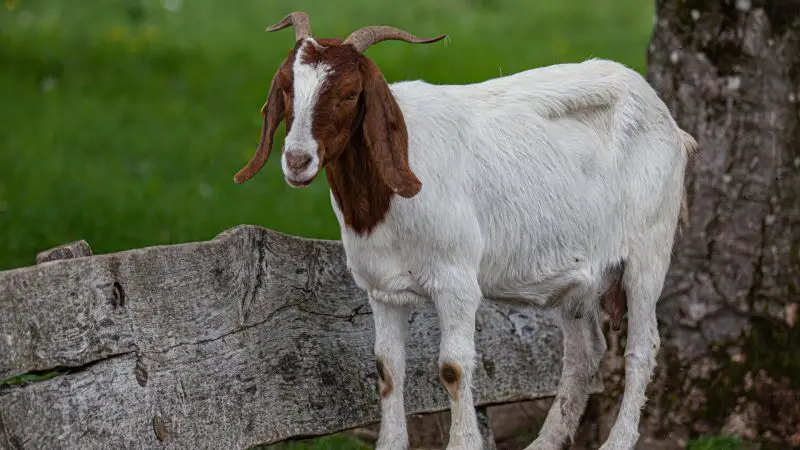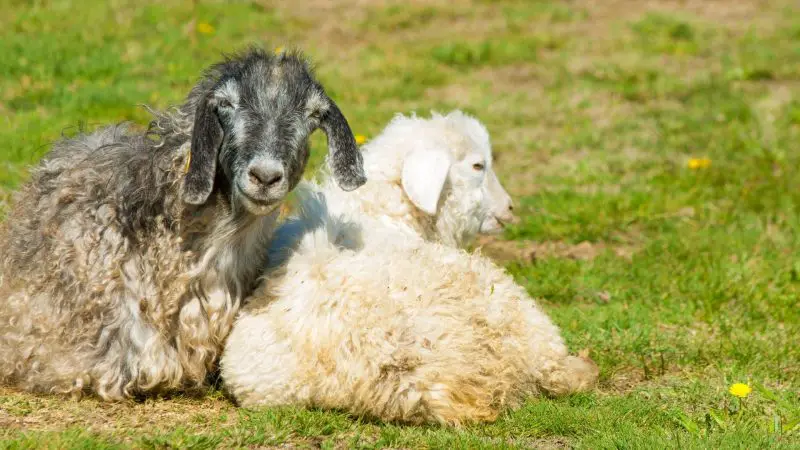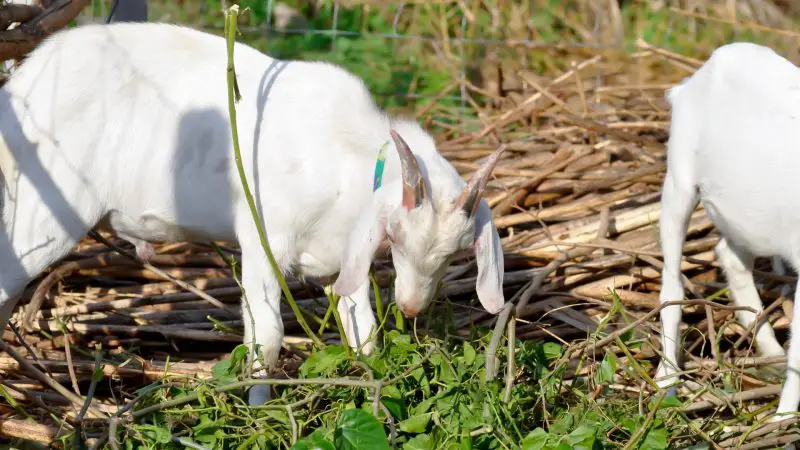Gulabi goats are not always found on every cattle farm. Hence, it’s right to call them uncommon. It’s also normal to be interested in adding rare species to your herd. But you have to know the proper ways of taking care of these animals.
Are Gulabi goats hard to raise? Gulabi goats are not hard to raise since they need attention and tending just like any other goats. However, they’re large goats, so you have to provide enough space for them. Allot at least twenty square feet for every goat in a building with a roof and walls. The place should be dry and clean, so it requires daily upkeep.
These essential preparations are also done when taking care of other animals. These goats get along well with other animals, and they learn quickly when trained.
Children can be around them, but adult supervision is still recommended. Aside from being amiable, more reasons make raising Gulabi goats worthy. You’ll find them in this article.
What Is Gulabi Goats? What Do They Look Like?

These are beautiful species of goats from Pakistan’s Sindh region. In its country of origin, they’re called Gulabi Pateri. Gulabi means ‘pink’ and Pateri means ‘belted’.
These terms represent their exact appearance as they’re pinkish-white with long, droopy ears. These goats are not only large but tall and leggy too.
Where Do Gulabi Goats Originate?
Gulabi goats originated from crossbreeding that involved four local goat breeds in Pakistan. They are as follow:
1. Kamori Goat
Hailing from Pakistan’s Sindh province, the Kamori buck weighs 60 kg while the doe is 50 kg. Generally, adult Kamori goats are in medium to large sizes. It has a distinct dark brown hue with some patches of coffee shade all over their bodies. Just like Gulabi goats, this goat species has long necks and ears.
The daily amount of milk that Kamori does can produce is 1.5 liters. Thus, this breed is fairly a good milk producer, and it’s regarded as a great meat provider.
2. Rajhanpuri Goat
It has a pure white body which is also seen on Gulabi goats. Both of them have long droopy ears. It has loose skin found under its chin and medium-sized horns. It’s also a dependable producer of milk and meat.
3. Pateri Goat
This white-colored goat is recognized for its good ability to produce meat. The milk from this breed has superb quality too. It has long drooping ears in a reddish-brown color, but it has a white face and neck. It has medium-sized horns too.
4. Beetal Goat
Beetal goat is also called ‘Lahori goat,’ and has a dual purpose because it takes part in meat and milk production. Its appearance is akin to Malabari goat and Jamunapari goat.
Moreover, it has a huge body with drooping ears. Its skin is valuable since it can be converted to fine leather.
How Did the Gulabi Goat Come Into Existence?

Beetal goat, Kamori goat, Pateri goat, and Rajhanpuri goat are crossbred, so this beautiful goat comes into existence. Two of them are primary crosses, and the other two are secondary crosses. With the fascinating outcome, there’s continuous work of crossing these goats.
How Long Do Gulabi Goats Live?
Generally, female Gulabi goats can live up to 16 years, while males can live for 10 years.
What Are the Gulabi Goat’s Traits?

- Size – Gulabi goats are pretty tall and large, so that’s why they’re perfect candidates for meat sources.
- Weight – The weight of adult female Gulabi goats ranges from 45 kg – 85 kg. The male ones are heavier, and they weigh 65 kg – 85 kg.
- Ears – The easiest way to identify Gulabi goats is by their drooping ears. They’re wide and hang down their shoulders. Excessive skin is rippled and wrinkled on their ears and under their chin.
- Other Features – Gulabi goats have fine, shiny fur, and the thickest part is found in their hind legs. They have low and flat horns. Moreover, they have a Roman nose.
- Milk production – The average amount of milk that a Gulabi goat produces is 2 to 3 liters a day. Its milk is not only tasty but healthy as it only has 3% of fat. Those who have given birth to mainly calves usually have more milk supply.
How Much Is a Gulabi Goat?
In Pakistan and India, the price range of Gulabi goats is from Rs 20 000 to Rs 35 000. In the USA, it’s around $7 000. This goat breed can be pricey, but it’s worth it as it can give more in meat and milk production.
How to Buy Gulabi Goats?
You have to look for reputable breeders of Gulabi goats. It’s best to find several of them and compare prices to get the best deal. This is an important consideration since some sellers overcharge.
Make sure that you buy one that is not younger than six months. Old goats are not a good investment at all.
Where Will You Get These Gulabi Beautiful Goats?
You can search on Craigslist to get these Gulabi beautiful goats but check it in person first before purchasing. Another way to find them is by going to your local livestock or 4H clubs. You may also participate in the livestock auction in search of these goats.
What to Consider in Buying a Gulabi Goat?
To determine the age, you can check the number of teeth, healthy coats, and well-formed udders. It’s recommended to buy a Gulabi goat that is not younger than 6 months.
A shiny, soft, and smooth coat is a sign of good health. It’s also good if you buy a pair to prevent loneliness and to produce more. Before bringing the goats to your farm, they must be vaccinated.
What Are the Production Features of Gulabi Goat?
Male goats become sexually mature at the age of 9 months to 1 year. The first-ever conception needs 18 months and the kidding period occurs every 8 months. In addition, the conception rate is at 90%, and kidding periods can happen thrice within two years. Also, it’s common for Gulabi goats to have three or four offspring.
What Are the Uses of Gulabi Goats?
They are used for meat, milk, and shows. Since they’re docile, they make adorable pets. But most breeders have them for meat and milk.
How Do You Raise Gulabi Goats?
These goats are not hostile so you can raise them in the usual shed or small farm. You have to build a well-aired shed for them to not invite diseases in. These animals dislike living in a wet, cold place, so you have to put them in an elevated shed.
The resting area and feeding area should be separated. You have to give them thick bedding to rest on and fresh straw to fill their stomachs. Always serve them fresh water to drink.
Since they’re large goats, each should be given 15 to 20 square meters of space or a larger area. You have to make another pen for expecting mothers so they feel safe from an aggressive buck.
Related: 5 Best Small Goat Breeds | Unexpected Reasons to Have Them!
How to Ensure the Health of Your Gulabi Goats?

Besides adequate nutrition and appropriate shelter, you have to do some things to keep Gulabi goats healthy. Vaccinations and routine treatment should be done based on the veterinarian’s advice. Observe extra caution for pregnant does and breeding bucks. Daily deworming is also necessary.
The new Gulabi goats that you bring to your farm should be quarantined to ensure that they don’t carry diseases that can affect other animals. After a certain period, they can be free.
How Do You Breed Gulabi Goats?
You have to let the buck stay with the doe for 40 – 45 days which is adequate time for the doe to be in heat twice.
The pair must not be together over 45 days, or else, the buck becomes tired, and breeding won’t be productive at all. Bear in mind that your goats should be healthy enough for breeding.
How Do You Choose a Good Breeder Gulabi Goat?
A Gulabo goat that is a good breeder excels in meat and milk production as well as raising healthy offspring. You’ll usually find this type of goat from a renowned breeder. Choose goats that are muscular and with lengthy necks.
The male goat is preferable of sufficient height and has loose skin. You have to look for a doe that has a firm and well-formed udder along with ideal teats.
How to Start a Gulabi Goat Farming?
- Choose the right area that is free from wetness and loud noises. You can make a shed or have someone do it for you.
- Prepare the goat feed and clean water for drinking. Supplements are needed for expecting mothers.
- You can start small by buying a pair. If you can manage, you can have 5 does and 1 buck since the mating ratio is 1 buck: 20 does.
Summary
Are Gulabi goats hard to raise? Since all the information you need to know is laid out in this article, it’s safe to say that it’s easy to raise these goats.
They require the same attention and care that other animals need. You have to give them a dry place to stay, nourishment, and vet recommendations to keep them comfortable and healthy.
List of Sources
Breed Use and Crossbreeding in Goat Production
